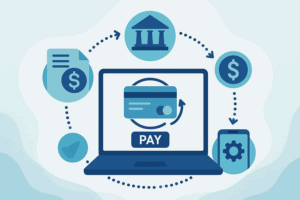 Cyber risks are no longer just an IT problem. Finance and cybersecurity now share the same battlefield.
Cyber risks are no longer just an IT problem. Finance and cybersecurity now share the same battlefield.
From ransomware freezing systems to phishing emails targeting CFOs, modern cyber attacks are smarter, faster, and almost always financially motivated.
In this post, we’ll break down how cyber threats are impacting financial operations, where you’re likely to be vulnerable, and what you can actually do to protect your team and your money.
Let’s get into it.
The Financial Fallout of Cyber Incidents
Cyberattacks don’t just cause data leaks—they hit your finances in real-time.
Ransomware = Locked Systems + Lost Revenue
Ransomware can freeze your accounting software, delay vendor payments, or shut down payroll. Every hour of downtime costs money and customer trust. If you aren’t aware of this type of attack, do get a brief on what is ransomware.
Phishing & Business Email Compromise (BEC)
Fake invoices. Impersonated CFOs. One wrong click, and your team wires thousands to a scammer. BEC is one of the top causes of financial loss globally.
In fact, BEC attacks are the second most expensive type of breach, costing an average of $4.89 million. One report found a 13% increase in BEC attacks in just the first 3 months of 2025, with a notable rise in gift card-related emails. BEC attacks make up more than 50% of all social engineering incidents.
Data Breaches Bring Fines & Lawsuits
If sensitive financial or customer data leaks, it triggers compliance issues, legal trouble, and expensive penalties. Think GDPR or PCI DSS fines.
For reference, by January 2025, the cumulative total of GDPR fines had reached approximately €5.88 billion. This underscores the strict enforcement of data protection laws and the rising financial repercussions for non-compliance.
Reputation Hits = Long-Term Revenue Loss
Modern finance operations run on interconnected end-to-end systems—and one of the most critical is the quote to cash process flow. This flow covers everything from issuing a quote to closing the deal, and is critical for ensuring smooth operations, accuracy, and timely revenue recognition. It’s how enterprises convert a sales opportunity into actual revenue.
When a cyberattack hits, it often targets points along this flow. Think about what happens if your quoting tool gets hacked or if your invoicing software goes offline due to ransomware.
Clients and partners lose confidence. Deals stall. Ultimately, they might even get cancelled, and your operating cash flow takes a direct hit. Even worse, if attackers manipulate pricing or payment terms in transit, it can lead to massive losses before anyone notices.
That’s why protecting the quote-to-cash process isn’t just a systems issue—it’s a strategic financial priority. Secure APIs, verified approvals, and routine checks across each step of the flow can go a long way in keeping your revenue pipeline protected.
How Modern Threats Are Getting Smarter
Cybercriminals have leveled up. And so has the dark tech backing them.
These aren’t hoodie-wearing hackers in basements. They’re organized, well-funded, and often backed by nation-states.
AI-Driven Phishing
Scam emails used to be full of typos. Now? They’re personalized, convincing, and lightning-fast—thanks to AI.
Your finance team could get a fake invoice that looks 100% legit. Unfortunately, finance staff aren’t always trained to spot phishing emails or unusual activity. They’re focused on numbers, not threat detection. And that makes them a target.
Also, as enterprise agents (powered by AI) become more common in operations—from reconciling invoices to approving vendor payments—it’s critical to ensure that these agents operate within strict access boundaries and logging protocols.
Supply Chain Attacks
Hackers aren’t always coming through your front door with brute force attacks or phishing emails.
Sometimes they sneak in through a vendor or third-party app your finance team uses daily—like payroll software or invoicing platforms. If just one of those has a vulnerability, your whole operation is exposed.
Many finance teams still use legacy software. It works, but it’s often full of security holes. Hackers love these systems because they’re easy to crack and rarely updated.
Credential Stuffing
Many finance tools still rely on basic logins. Hackers use stolen passwords from one site to break into another
If your finance manager reuses a password, boom—your books are wide open.
Insider Threats
Not every threat comes from outside. Disgruntled employees or careless contractors can leak, steal, or expose sensitive data.
Sensitive data often lives in Excel sheets floating around in inboxes or cloud folders with weak permissions. No encryption. No access control. High risk.
The bottom line: Finance teams are more exposed than they realize. It’s about time you get proactive about protecting your financial operations.
Building a Cyber-Resilient Finance Function
You don’t need to turn your finance team into cybersecurity experts. But you do need to make resilience part of the workflow.
Harden Your Tech Stack
Start with the basics:
- Use multi-factor authentication (MFA) for every finance tool.
- Keep all software up to date. No skipped patches.
- Encrypt sensitive data—at rest and in transit.
- Invest in EDR/XDR tools (endpoint detection & response) if you can.
Apply Zero-Trust Principles
Don’t assume anyone—or any system—should have access by default.
- Give employees access to only what they need.
- Log and monitor who’s doing what.
- Require identity checks at every step. Even for internal tools.
Set Finance-Specific Security Policies
Use dual approvals for high-value transactions. Block personal email accounts from accessing shared folders.
Also, enable alerts for anomalies like off-hours logins or unexpected payments.
Practice Incident Response
Simulate attacks. Involve the finance team. Think about it:
- What if your invoicing system went down today?
- Who handles vendor communications?
- How will you keep the cash flowing?
A plan is only good if people know how to use it.
What Finance Teams Can Do Right Now
No need to overhaul everything overnight. Start small. Then scale up.
Here’s a quick-action checklist:
- Lock Down Payment Workflows
Use approval tiers for all transfers, especially high-value ones. Set alerts for unusual transaction patterns.
- Run a Phishing Drill
Test how your team responds to fake (but realistic) phishing emails. Use it as a teaching moment, not a blame game.
- Audit Your Access
Who has access to your accounting tools? Remove anyone who doesn’t need it. Make sure only verified users can see or edit financial data.
- Talk to IT About Finance Tools
Schedule a short review of every platform you use: payroll, invoicing, ERP. Check for updates, vulnerabilities, and MFA settings.
- Back Up Everything (And Test It)
Make sure financial data is backed up securely and regularly. Run a restore test. If you can’t recover it, the backup’s useless.
These are all things you can kick off in a week or less. No major budget required.
Tools & Resources to Consider
It’s fair to assume that good cybersecurity demands deep pockets. To some extent, that’s true. But that’s not entirely the case.
You don’t need a huge IT budget to tighten things up. Just a few well-chosen cybersecurity tools can make a big difference.
Here are a few expert-handpicked ones you can consider.
For Fraud Detection & Monitoring
- Agari, Abnormal Security: Stops business email compromise before it hits inboxes.
- Tesorio or Tipalti: Finance automation tools with built-in fraud controls.
For Secure File Sharing
- Egnyte, Tresorit: Better than email or Google Drive when it comes to security.
- When deciding, look for tools that offer role-based access and audit logs.
- Also, if you’re using tools like an SBA loan calculator to project funding needs or repayment schedules, ensure they’re hosted on secure platforms with access controls and encryption in place.
For Endpoint & System Security
- CrowdStrike, SentinelOne: Great for monitoring unusual activity across devices.
- If you’re using a managed IT provider, ask what’s already included.
Training & Awareness
- KnowBe4, Hoxhunt: Phishing simulations and bite-sized security training.
- Finance-specific modules are often available.
Cyber Insurance (Yes, Really)
Did you know something like this exists? Well, there are plenty of cyber insurance plans for businesses of all sizes available today.
Look for policies that cover financial fraud, business interruption, and data breach recovery. It’s not a fix-all, but it helps when things go sideways.
Wrapping Up
Cyber threats aren’t just IT headaches anymore. They’re direct hits to your bottom line and can come your way via your financial ops.
From deepfake scams draining millions to ransomware freezing your payment systems, the message is clear: finance teams need to care about cybersecurity. Not tomorrow. Today.
But here’s the upside—getting ahead of these risks isn’t rocket science. With the right habits, tools, and a little teamwork with IT, your finance function can go from vulnerable to resilient.
Think of cybersecurity not as a cost, but as protection for your cash flow, your reputation, and your ability to operate.
FAQs
How do cyberattacks affect financial operations?
Cyberattacks can halt payment systems, delay payroll, enable fraud, and lead to data breaches that result in heavy fines, legal issues, and reputational damage.
What is the most common cyber threat to finance teams?
Phishing and business email compromise (BEC) are the most common. These scams often target finance staff with fake invoices or impersonated emails from executives.
Can cybersecurity really help save money?
Yes. A strong cybersecurity strategy prevents costly incidents like fraud, system downtime, and compliance fines—ultimately saving significant money in the long run.
What tools should finance teams use for cybersecurity?
Look for tools that offer fraud detection, secure file sharing, phishing awareness training, and access control. Multi-factor authentication is a must.
Who is responsible for cybersecurity in finance teams?
While IT manages the infrastructure, finance leaders are responsible for securing workflows, enforcing controls, and training staff to avoid risks.
How can a small finance team get started with cybersecurity?
Start by locking down access, enabling MFA, training staff on phishing, reviewing your finance tools with IT, and testing your data backups regularly.

















